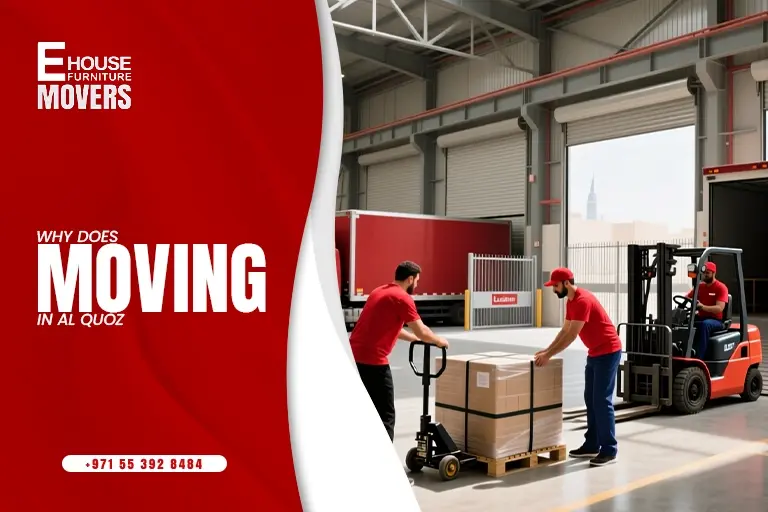Moving from Dubai to Abu Dhabi requires structured planning because the relocation covers a long inter-emirate distance, involves building permits in two jurisdictions, and depends on a step-by-step sequence that must be completed within scheduled access hours. The route between Dubai and Abu Dhabi spans approximately 140–160 kilometers, which increases the importance of secure packing, balanced truck loading, and safe highway transport. Both origin and destination buildings require move-out and move-in approvals, along with pre-booked service elevators and verified vehicle entry, which must be arranged before dispatch. A professional mover coordinates these requirements, manages the packing workflow, controls the loading order, oversees transit timing, and performs complete unloading and furniture setup at the destination. Understanding these logistical elements helps residents plan a predictable, efficient, and compliant move between the two emirates.
Table of Contents
ToggleWhy do people hire movers for a Dubai to Abu Dhabi relocation?
People hire movers because a Dubai-to-Abu Dhabi relocation spans around 140-160 km, involves inter-emirate transit, and requires coordination of long-haul transport, building access, and setup at destination. The driving distance between Dubai and Abu Dhabi is approximately 140 km (87 miles) via the main highways. A professional mover brings specific benefits in handling the packing, transport and setup phases.
What are the main benefits of hiring professional movers for this route?
Hiring professional movers offers benefits including comprehensive packing, safe long-distance transport, time-efficient execution, compliance with building rules, and full room-by-room setup at destination.
Key benefits that clients receive:
- Expert packing using reinforced materials and protective coverings for the longer corridor transit.
- Secure loading and balancing of items for highway travel across emirates.
- Faster job completion: reducing the relocation timeline because professionals coordinate every step.
- Handling of building access requirements, permits and elevator bookings in both Dubai and Abu Dhabi.
- Full unloading, furniture re-assembly, placer-out by room, and waste clean-up at destination.
What permits and building approvals are required for a Dubai to Abu Dhabi move?
Permits and approvals include move-out permits in Dubai, move-in permits in Abu Dhabi, service elevator bookings, vehicle access approvals, tenancy or ownership documentation, and building-specific NOCs.
Details:
- In Dubai, many communities demand a move-out permit from the developer or management company. Documents typically include tenancy agreement or ownership certificate, Emirates ID or passport copy, and utility clearance.
- In Abu Dhabi, residential buildings commonly require a building NOC/Move-In Permit before large item deliveries or use of service elevator/loading bay. Outstanding bills or tenancy registration (Tawtheeq) may block permission.
- Both origin and destination buildings may require submission of the moving company’s details, truck registration, floor numbers, dates and times.
Why do buildings impose these permit and access requirements?
Buildings impose permits to manage security, coordinate loading bay use, prevent congestion of service elevators, protect property infrastructure, and ensure tenant compliance with building rules.
These requirements check that:
- The tenant identity and contract are valid.
- The moving company is approved by management.
- The vehicle, date and route are registered.
- Elevator or loading bay usage is pre-booked so other residents are not disrupted.
Failing to obtain required permits may result in access refusal, extra fees or delays.
What does move-day look like for a relocation from Dubai to Abu Dhabi?
Move-day follows a precise sequence: pre-move inspection, packing, disassembly, loading, long-haul transit, arrival checks, unloading, re-assembly and final setup.
Detailed sequence:
- Pre-move inspection: Movers survey the home in Dubai, confirm inventory, identify large items and access constraints.
- Packing stage: Household goods are packed room-by-room using moving blankets, bubble wrap, stretch film, mattress covers and reinforced boxes.
- Disassembly: Large furniture (beds, wardrobes, dining tables) are dismantled to facilitate loading.
- Loading the truck: Loading order is critical: heavy items at base; mattresses and sofas stored vertically; fragile boxes on top; all items secured with straps and braces for transit across the approx. 140 km corridor to Abu Dhabi.
- Transit: The truck travels along the major inter-emirate highway (typically E11 / Sheikh Zayed Road) from Dubai to Abu Dhabi, with expected driving time around 1 h 15 m to 2 h depending on origin and traffic.
- Arrival & verification: At destination building in Abu Dhabi, movers present the move-in permit/loading bay booking. Security verifies credentials and allows access.
- Unloading & room placement: Items are moved into correct rooms according to labels, furniture re-assembled by the crew, and final layout confirmed.
- Final walkthrough & cleanup: Movers remove packing debris and client signs off.
How is packing and securing cargo different for inter-emirate moves?
Packing and securing for a Dubai-to-Abu Dhabi move requires stronger materials, more robust protection and secure load-bracing due to longer distance and higher vibration levels.
Specific measures:
- Use heavy-duty boxes and double-wall corrugated cartons for fragile items.
- Wrap furniture in moving blankets and secure with stretch film.
- Strap heavy appliances and furniture to prevent shifting.
- Store mattresses and large glass items vertically to minimise movement.
These practices reduce damage risk on the longer interstate-style route.
What is the typical distance and travel time between Dubai and Abu Dhabi for a moving truck?
The typical driving distance is between 140 km and 150 km, and travel time by car is approximately 1 hour 15 minutes to 2 hours depending on traffic and route.
Sources indicate: approximately 140 km (87 miles) via the E11 highway, with usual driving time 1 h 15 m under optimal conditions. Moving trucks may take longer due to vehicle size, loading/unloading time, building access and possible traffic delays.
What safety and regulatory considerations apply during the transit and building access?
Safety and regulatory considerations include truck licensing and access, driver fatigue management, speed limits for heavy vehicles, building loading bay guidelines, and proper documentation checks.
- UAE speed limit regulations for heavy vehicles apply; trucks often have speed limiters and regulated allowable speed on highways.
- Buildings require verified truck registration and driver details to grant access.
- Elevator and loading bay use must comply with building codes such as the Dubai Building Code, which regulates contractor access and safety.
- Movers must monitor driver rest periods and avoid fatigue given the substantial distance.
How does a professional mover reduce stress and avoid delays for the client?
A professional mover reduces stress by handling all logistical steps from permits to packing, coordinating scheduling, providing a structured team, managing transport and final setup, and coordinating with both building management teams.
Clients benefit by:
- Avoiding permit-related delays or denial at buildings.
- Having a team that knows loading bay restrictions, truck size limitations and elevator time-slots.
- Receiving faster transition and setup at destination.
- Minimising damage risk due to professional packing.
- Receiving clear work-flow from start to finish.
Summary
A Dubai-to-Abu Dhabi move involves professional logistics across inter-emirate distance, compliance with permits in two jurisdictions, specialist packing and loading for long haul, safe transit of approximately 140 km, and organised unloading and setup at destination. The mover’s role includes securing origin and destination building approvals, executing efficient packing and truck loading, navigating highway transit, performing unloading with room-by-room placement, and coordinating final completion. When each step is properly managed, the relocation is smooth and predictable.
Also Read: Hidden Charges to Watch When Moving in Dubai




